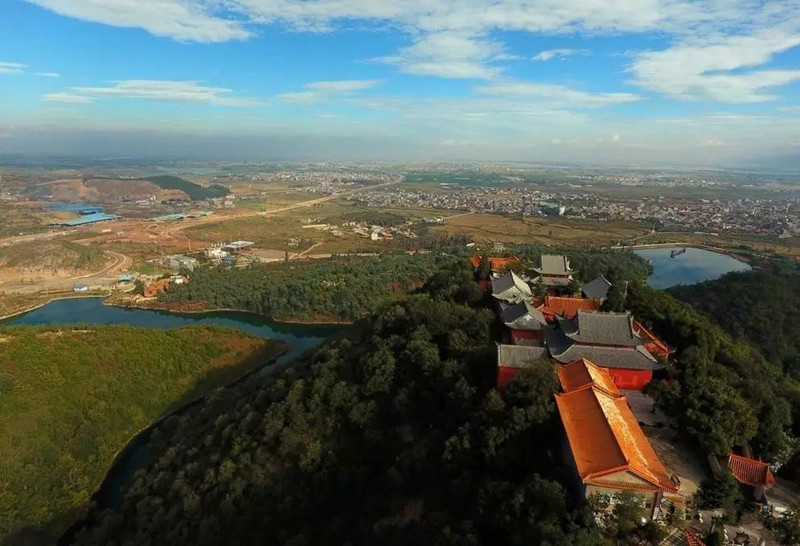Zhongnanshan Mountain in Luliang County, Qujing
Overview
Zhongnanshan (终南山), located in Shiguan Village (仕官村), Majie Town (马街镇), 18 kilometers southeast of Lujiang County (陆良县) in Qujing City (曲靖市), is one of the three famous mountains of Lujiang. Situated 15 kilometers from the county seat and adjacent to Wufeng Mountain (五峰山), Zhongnanshan has a rich historical background. Legend has it that during the Song Dynasty, Emperor Wen of Song used it as a retreat from the heat.
In the late Song to early Ming dynasty, the area was held by the local chieftain Long Hai (龙海), who built fortifications on the mountain, named Yingpan Mountain (营盘山), to resist the Ming army. When the Ming forces captured the camp, they set it ablaze. By the mid-Ming dynasty, a palace was constructed at the mountain’s peak, commonly known as Zhongnanshan Temple (终南山寺). It was rebuilt during the ninth year of the Kangxi era (康熙九年) and further expanded into a Buddhist monastery, renamed Juezhiao Temple (觉照寺) in the second year of the Jiaqing era (嘉庆二年) under the stewardship of the Guangxi scholar Hengrong (恒荣). The temple has been rebuilt multiple times due to fire damage, with restoration efforts beginning in 1990. Behind the temple, there are stupas dedicated to monks who passed away during the Qianlong (乾隆) and Jiaqing (嘉庆) eras, symbolizing the ancient Buddhist culture in a serene setting. In front of the temple lies the “Yaowang Spring” (药王泉), where it is said that the immortal Nanji Xianweng (南极仙翁) once lived. Local lore suggests that a monk released a dry eel into the pool, which has kept it from drying up.
The “Prince’s Tomb” (王子坟) behind the mountain resembles a woman lying on her back, legs bent but not stretched out, which locals refer to as “Beautiful Maiden’s Longing” (美女相思), similar to the legend of the Sleeping Beauty in Kunming’s Western Hills (昆明西山). Below the mountain, Zhongnanshan Lake (终南山湖), also known as Zhongnanshan Reservoir, is surrounded by mountains on three sides, covering an area of 13.2 square kilometers, with crystal-clear waters that mirror the stunning scenery.
Scenic Features
Zhongnanshan boasts dense forests filled with towering ancient trees and fragrant flowers. From a distance, the mountain is a lush expanse of greenery with pavilions, red-walled temples, and serene waters. Up close, the still waters reflect the mountain’s beauty, with deep valleys and opposing peaks creating a stunning landscape.
Traveling along the winding mountain roads to the summit, visitors are greeted with grand temples and a refreshing atmosphere. Overlooking the mountain’s flanks, you can spot the “Tiger Pouncing on Sheep” on the left, the “Yama’s Seat” (阎王静座) on the right, and the “Golden Turtle” and “Two Dragons Playing in Water” peaks in front—five exquisitely shaped mountains. The tranquil waters of Zhongnan Lake and the sound of morning bells and evening drums from the temple create a transcendent experience.
Zhongnanshan is known for its breathtaking scenery, filled with pine and oak trees and wildflowers. In the mid-Ming dynasty, Xuan Emperor’s Palace (玄帝宫) was built at the mountain’s peak, a Taoist temple. According to Zixi Chuan (紫溪传), there was a two-zhang-long stone fish near Zhongnanshan that would jump into the stream during floods, causing damage to nearby fields. The locals, wishing to control this water disaster, built a temple in gratitude after the deity Xuantian Shangdi (玄天上帝) vanquished the fish.
Rebuilt during the ninth year of Kangxi (1670 AD) and expanded by scholar Huanrong (桓荣) in the second year of Jiaqing (1797 AD), the temple continues to draw crowds annually, especially during the third day of the third lunar month when devotees come to offer incense, creating a vibrant scene reminiscent of a colorful dragon winding up the mountain.
How to Get There
To reach Zhongnanshan, take a bus from Qujing City to Lujiang County. Once in Lujiang, taxis or local transport options are available to take you to Majie Town, where you can access Zhongnanshan.
Travel Tips
- Wear Comfortable Footwear: The mountain trails can be steep and rocky, so sturdy shoes are recommended.
- Bring Essentials: Carry water, snacks, and sun protection as you may spend several hours exploring.
- Respect the Environment: Follow designated paths and avoid littering to preserve the natural beauty of the area.
- Plan for Crowds: If visiting during festivals or holidays, expect large crowds and plan your trip accordingly.
- Photography Opportunities: The stunning landscapes provide excellent opportunities for photography, but be mindful of any restrictions, especially in sacred areas.


















